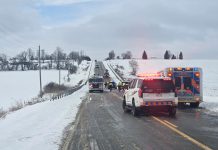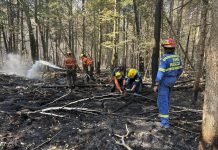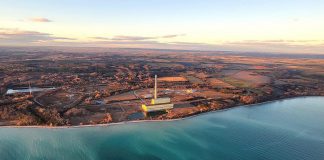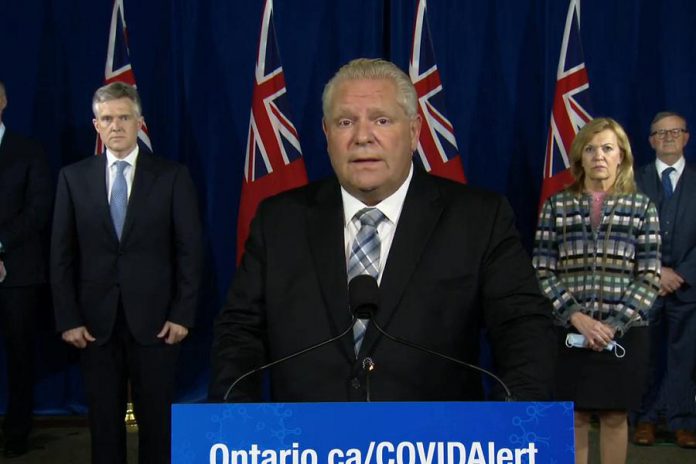
With Ontario reporting a record surge of 939 new COVID-19 cases on the eve of the Thanksgiving weekend, the Ontario government is urging everyone to limit trips outside of home and to avoid non-essential travel.
The government is asking Ontarians to only leave home for essential purposes such as work (where it is not possible to work from home), school, grocery shopping, medical appointments, and outdoor healthy physical activity, and to only travel to other regions in the province — especially from higher transmission to lower transmission areas — when essential.
The province also announced additional public health restrictions in Toronto, Peel, and Ottawa — the three regions of the province with 612 of the new cases — including no indoor food or drink service at bars and restaurants and the closure of gyms, casinos, movie theatres, performance venues, and more for at least the next 28 days.
Premier Doug Ford made the announcement at a media conference at Queen’s Park on Friday (October 9), along with health minister Christine Elliott, finance minister Rod Phillips, Ontario’s chief medical officer of health Dr. David Williams, and Adalsteinn Brown, dean of the Dalla Lana School of Public Health at the University of Toronto.
“In the last week, the pandemic has picked up speed at an alarming rate,” Ford said. “The situation today is extremely serious. On September 1st, we had just over 110 new cases. Five weeks later, today, we’re at 939 new cases.”
“As we post record testing numbers, the percentage of people testing positive is rising too quickly, with some communities showing as high as a 10 per cent positivity. The virus is starting to spread to older people. The number of contacts for every confirmed case has exploded, sometimes in the thousands. All trends are going in the wrong direction. Left unchecked, we risk worst-case scenarios first seen in Italy and New York City.”
Ford warned of the potential of the virus to spread again in long-term care homes, “something we must avoid at all costs”. He said there has been already been a 250 per cent increase in the number of hospitalizations and the number of people in intensive care units, and that the number of admissions to ICUs will more than triple in less than 30 days if current trends continue — overwhelming Ontario’s hospitals.
“We have to do everything possible to prevent widespread lockdowns, and we cannot go back to Stage 1,” Ford said. “We need to keep our schools open and protect our long-term care homes — that’s our top priority, nothing matters more.”
Ford said his cabinet reviewed the recommendations of Ontario’s top public health officials during an emergency meeting this morning, and accepted all of them.
Effective at 12:01 a.m. on Saturday (October 10), Toronto, Ottawa, and Peel will be in a “modified Stage 2” with the following measures in place:
- Reducing limits for all social gatherings and organized public events to a maximum of 10 people indoors and 25 people outdoors where physical distancing can be maintained. The two limits may not be combined for an indoor-outdoor event.
- Prohibiting indoor food and drink service in restaurants, bars and other food and drink establishments, including nightclubs and food court areas in malls.
- Closing of: indoor gyms and fitness centres (i.e., exercise classes and weight and exercise rooms); casinos, bingo halls and other gaming establishments; indoor cinemas; performing arts centres and venues; spectator areas in racing venues; interactive exhibits or exhibits with high risk of personal contact in museums, galleries, zoos, science centres, landmarks, etc.
- Prohibiting personal care services where face coverings must be removed for the service (e.g. makeup application, beard trimming).
- Reducing the capacity limits for: tour and guide services to 10 people indoors and 25 people outdoors; real estate open houses to 10 people indoors, where physical distancing can be maintained; in-person teaching and instruction (e.g. cooking class) to 10 people indoors and 25 people outdoors, with exemptions for schools, child care centres, universities, colleges of applied arts and technology, private career colleges, the Ontario Police College, etc.; and meeting and event spaces to 10 people indoors and 25 people outdoors.
- Limiting indoor team sports to training sessions (no games or scrimmages). A decision has not been made on outdoor team sports.
Schools, child care centres, and places of worship will remain open in these communities but must continue to follow the public health measures in place. Before-school and after-school programs will also be exempt from these new restrictions.
Given the extraordinary costs associated with these functions, wedding receptions scheduled for this weekend may proceed under existing public health rules. Effective Tuesday (October 13) at 12:01 a.m., updated public health measures will apply to wedding receptions, including new gathering limits of 10 people indoors and 25 people outdoors at event spaces.
The measures in Toronto, Peel, and Ottawa will remain in effect for 28 days, after which they will be reviewed by Ontario’s top public health officials.
“I can’t stress enough how difficult, how painful, it was to make this decision,” Ford said. “My heart just breaks for these folks, and I understand what this decision means to each and every one of you. I can tell you, I didn’t sleep last night. Believe me, this weighs heavy on me, making this decision. I know what this will do to businesses who are already struggling.”
Ford then addressed business owners and workers directly, saying he would do “everything in my power” to support them.
In addition to the federal government’s package of economic supports announced earlier today (including rent subsidies directed to business owners, the extension of the wage subsidy program, and additional funds for business loans), Ford announced $300 million in provincial funding to support small businesses in the affected regions with their fixed costs over the next 28 days, including waiving provincial and municipal property tax bills and hydro and natural gas bills.
AUDIO: Ontario Premier Doug Ford announces additional financial support for businesses
Ford’s media conference followed a media briefing earlier in the afternoon where Adalsteinn Brown, Dr. Williams, and Dr. Dirk Huyer (Ontario’s chief coroner and executive lead of COVID-19 teting) provided details on the rationale behind the new restrictions.
At that briefing, Brown said the positivity rate in older populations is now at 1.4 per cent, more than three times the rate in early August. He said hospitalizations have gone up by 250 per cent over the past three weeks and Ontario ICU occupancy is predicted to exceed the threshold where the health care system can maintain scheduled surgeries and other acute care services, even in best-case scenarios.
Williams said that the positivity rate in Toronto, Peel, and Ottawa is significantly higher than in other areas of the province. With community transmission now reaching 25 per cent, testing and contact tracing is no longer sufficient to identify and control the spread. The latest reports from public health units show the number of contacts for confirmed cases has reached as high as 100 people, which makes it very difficult to trace and isolate these cases.
Huyer said the intention of the new measures in Toronto, Peel, and Ottawa is to prevent the potential spread of the virus in long-term care homes and schools. He said the virus is primarily spreading where people gather inside, in close proximity and without wearing masks, such as a group of friends getting together inside a restaurant — despite restaurant owners and employees following proper protocols.
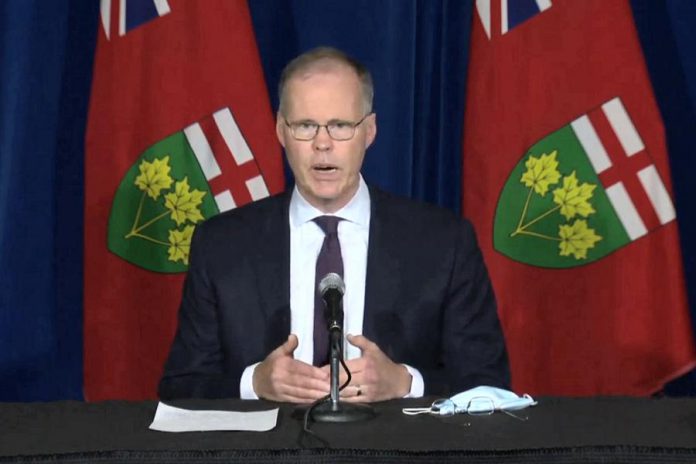
Brown and Williams said there is not much evidence of transmission within schools among staff and students, that most of the cases in schools are a result of infected people from the community coming into the schools.
Williams said there are no travel restrictions in place between other regions of the province and Toronto, Peel, and Ottawa and other regions of the province, but travel to and from the “hot zones” is discouraged. He said public health officials will be closely monitoring the situation in regions adjacent to Toronto, Peel, and Ottawa, and that measures could be extended to these other regions if required.
Finally, Williams said he is waiting for recommendations from the Public Health Measures Table on public health guidance on how to safely celebrate Halloween.



